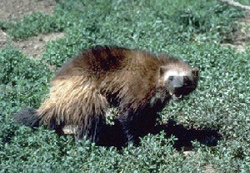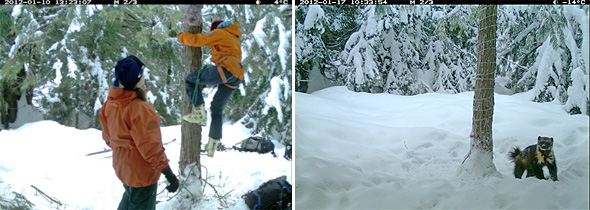Wolverine: legendary enigma
Mount Revelstoke National Park
The wolverine is an enduring symbol of deep wilderness, dogged determination and fierce independence. Their lives may be best described as wandering from valley bottom to alpine tundra in a continual search for food.
Wolverines are Blue-listed as a species of special concern by the government of British Columbia and are under federal reassessment by the national Committee on the Status of Endangered Wildlife in Canada (COSEWIC). Wolverines have a low-reproductive rate, require large home ranges and are sensitive to human activities and habitat fragmentation created by development1.

Wolverine - Gulo Gulo
Identification | Range | Reproduction | Population | Diet | Identifying Wolverine Tracks | Conservation Concerns | Current Research | Past Research | How You Can Help
Identification
The wolverine is the largest member of the weasel family. The wolverine is often mistaken for a small bear or large hoary marmot. Close in size to a medium dog, males weigh between 12 and 16 kg, while females are usually smaller. They have a rich, chocolate brown coat with blonde stripes down the sides. Individuals have unique silvery markings on their broad face.
Range
Wolverines cover a phenomenal amount of territory, often going right over mountains instead of taking the easy way around. Males have home ranges of 230 to 1580 km2, while females, especially those with young, maintain a much smaller home range, generally 50 to 400 km2 1. In the Columbia Mountains, backcountry skiers are known to spy their tracks traversing mountain ridge tops, high passes and deep, remote valleys.
In North America, wolverines range as far south as California, but south of the boreal forest, they are typically found only in the most rugged mountain ranges, including Canada's Rocky and Columbia Mountains1.

Backcountry skier © Parks Canada - Jordy Shepherd
Reproduction
Wolverines mate between April and September, but embryo implantation is delayed many months and young are typically born between late March and mid April. Reproduction rates are low (2-3 kits) and females do not bear young every year1. In addition, poor nutrition caused by scarce food and increased stress from disturbances may stop a female from bringing a pregnancy to term (Persson 2005).
Come late winter, pregnant females move to higher elevations to den among large snow covered boulders or talus slopes (Krebs and Lewis 2000).
Did you know?
Possibly to blend in with their snowy environment, wolverine kits are cream coloured when they are born1
Population
If you see a wolverine, consider yourself lucky, for they are few and far between. While we don’t presently have a population estimate for Mount Revelstoke and Glacier national parks, research from a study in the 1990s indicates the population in the Northern Selkirk Mountains to be approximately 1 wolverine for every 167 km2 (Krebs and Lewis 2000). Of this area, Glacier is 1349 km2 and Mount Revelstoke is 260 km2.

Diet
The wolverines' appetite is legendary. Their scientific name, Gulo gulo, comes from the Latin word for glutton, but really they eat no more than any other animal their size. It's just that they aren't particularly picky eaters. Once thought to be almost exclusively eaters of carrion, we now know they are accomplished predators. They will kill caribou and goats, animals several times their size; they also prey on small mammals such as marmots, porcupine, ground squirrels and being omnivore, will eat roots and berries1. Much of their diet consists of large mammals that were previously killed by predators or avalanches1.
Identifying Wolverine Tracks
- Wolverine track sequences are usually in sets of three prints, about the size of a large dog. Look closely at the middle print - it's actually made by two paws.
- Tracks may also be in sets of 4 (like lynx or wolf) or 2 (like fisher and marten).
- All five toes and claws are usually visible. Only four toes register for lynx (no claws) and wolf (claws visible) tracks.

FRONT- 5th toe on front doesn't always show. Height: ~ 12 cm (~ 4.5")

BACK - heel pad doesn't show on rear track. Height: ~ 10 cm (~ 3.5")

Walk / © Parks Canada / B. Bertch

3 track / © Parks Canada / B. Bertch

Bound pattern: pine marten on left and wolverine on right / © Parks Canada / B. Bertch
Conservation Concerns
Did you know?
Research indicates that wolverines that spend the majority of their time in protected areas have a higher survival rate (Krebs et al 2004)
Wolverines in western Canada, including the Mountain Parks, have been recommended as a Species of Special Concern by the national Committee on the Status of Endangered Wildlife in Canada (COSEWIC). This ranking reflects their low numbers and slow capacity to recover from population declines1. Both Alberta and British Columbia provincial governments recognize wolverine as a species that may be at risk and require special management considerations. Canada's Mountain National Parks play an important role in providing valuable habitat for the wolverine. But, because wolverines require a large home range, the ones that call these parks home only spend a portion of their lives within the park boundaries.
Despite their fearsome reputation, the wolverine is susceptible to a number of threats including: disturbance in winter by backcountry skiers, heliskiers and snowmobilers (Krebs et al. 2007); human activity that may result in den abandonment (Magoun and Copeland 1998); decline in food sources such as Mountain Caribou1 and predator species that provide carrion for wolverine1; habitat loss and fragmentation1; mortality caused by the harvesting of pelts1; road and railway strikes1 and climate change impacts on habitat (Copeland et al. 2010).
Wolverines are a wide-ranging, low-density species that are important indicators of ecosystem health1. Protected within the boundaries of the national parks, they still face threats such as reduced landscape connectivity caused by transportation corridors and human disturbance in the form of recreation near den sites1. Denning females leave their young alone for up to several days while they search for food during the late winter1. The young are helpless and vulnerable, so mothers ensure they are in a secure den, safe from potential predators. Unwittingly, backcountry recreationalists may risk disturbing a female with kits, forcing her to find a new den and move her young. Mount Revelstoke and Glacier national parks are subject to increasing winter recreation pressure and increasing traffic flows along the existing transportation corridor. These factors may be affecting the range, connectivity and genetic diversity of the wolverine population.

Researchers and a wolverine at a research station in Glacier National Park
Current Research
Currently, Parks Canada is collecting wolverine DNA from hair samples in Mount Revelstoke and Glacier national parks to determine the presence and behaviour of wolverine in relation to the Trans Canada Highway (TCH) and railway lines. This will help determine the potential need for and placement of crossing structures if the highway is expanded. It will also help determine where restrictions in gene flow may be occurring across wolverine range. The hair samples from wolverine are collected on barbed wire at baited stations. This is a genetic sampling technique used to collect data on wolverine occurrence, distribution and genetics. Each sampling site has a remote camera that helps confirm animal visits to the site and acts as an additional method of detection. This kind of research was established by biologists conducting wolverine research in the Rocky Mountains (www.albertawolverine.com and www.wolverinewatch.org).

Wolverine hair samples
Past Research
A wolverine research project was conducted in the North Columbia Mountains in the mid-1990’s (Krebs and Lewis, 2000; Krebs et al. 2004; Krebs et al. 2007) by the Columbia Basin Fish and Wildlife Compensation Program in collaboration with Parks Canada, the Ministry of Forests and the Habitat Conservation Trust Fund. This project determined home range size, mortality causes, habitat use and population estimates. The study area was centred north of Glacier National Park and included the Trans Canada Highway corridor. During the project, one collared wolverine was killed on the railway and one on the highway. The Trans Canada Highway corridor is thought to form a partial barrier to wolverine distribution. Wolverines in the study area were also found to be sensitive to recreational pressure (Krebs et al. 2007).
How You Can Help
When in the backcountry, observe all wildlife tracks closely. Not only does this help you to learn more about the behaviour of wildlife, but this increased awareness can also help you to avoid causing undue stress on sensitive species like wolverine. Remember, never follow tracks toward an animal and if you suspect you are near a wolverine den site, please leave the area immediately and notify park staff on your return. Common den sites may be identified by several sets of tracks leading to and from a hole in the snow. Please do not approach dens.
Any wolverine tracks you observe provide useful information for park biologists currently investigating wolverine distribution and ecology in the parks. Note your position, date and time; if you have a GPS unit, please record the UTM co-ordinates, describe if the tracks are fresh or snow covered, the estimated size and spacing of the tracks, and if you are able, take a photo.
Please return your observations to:
In person: to park visitor centres or warden offices
Email: Revglacier.Reception@pc.gc.ca
Phone: 250.837.7500 or 250.837.7553
Related links
More information on wolverine research projects in the Columbia Mountains:
- J. P. Copeland, K. S. McKelvey, K. B. Aubry, A. Landa, J. Persson, R. M. Inman, J. Krebs, E. Lofroth, H. Golden, J. R. Squires, A. Magoun, M. K. Schwartz, J. Wilmot, C. L. Copeland, R. E. Yates, I. Kojola and R. May. 2010. The bioclimatic envelope of the wolverine (Gulo gulo): do climatic constraints limit its geographic distribution? Canadian Journal of Zoology 88:233-246.
- J.A. Krebs and D. Lewis. 2000. Wolverine ecology and habitat use in the North Columbia Mountains: Progress Report. 1999. Proceedings of a Conference on the Biology and Management of Species and Habitats at Risk, Kamloops, B.C., 15-19 Feb, 1999. Volume Two. BC Ministry of Environment, Lands and Parks, Victoria BC and University College of the Cariboo, Kamloops, BC. 520 pp.
- J. Krebs, Lofroth, E., Copeland J., Banci, V., Cooley, D., Golden, H., Magoun, A., Mulders, R. and B. Shults. 2004. Synthesis of survival rates and causes of mortality in North American wolverines. Journal of Wildlife Management 68(3): 493-502.
- Krebs, J., E. C. Lofroth, and I. Parfitt. 2007. Multiscale habitat use by wolverines in British Columbia, Canada. Journal of Wildlife Management 71: 2180–2192.
- Lofroth, E. C., and J. Krebs. 2007. The abundance and distribution of wolverines in British Columbia, Canada. Journal of Wildlife Management 71: 2159–2169.
- Magoun, A.J., and J.P. Copeland. 1998. Characteristics of wolverine reproductive den sites. Journal of Wildlife Management 62:1313-1320.
- Persson, J. 2005. Female wolverine reproduction: reproductive costs and winter food availability. Canadian Journal of Zoology 83:1453–1459
- Ruggiero, L. F., McKelvey, K. S., Aubry, K. B., Copeland, J. P., Pletscher, D. H. and M.G. Hornocker. 2007. Wolverine Conservation and Management. The Journal of Wildlife Management. 71: 2145–2146.
- COSEWIC 2003. COSEWIC assessment and update status report on the wolverine Gulo gulo in Canada. Committee on the Status of Endangered Wildlife in Canada. Ottawa. vi + 41 pp.
1Committee on the Status of Endangered Wildlife in Canada (COSEWIC), 2003.
- Date modified :